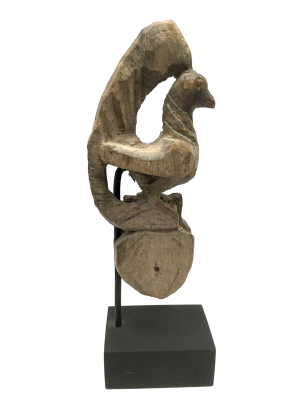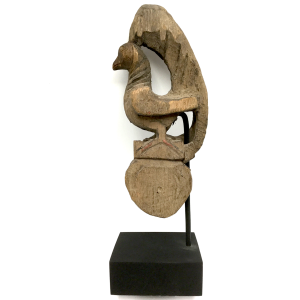-
Sale!


$235.00 Original price was: $235.00.$150.00Current price is: $150.00.
H: 10.5” W: 3.25” D: 2.375” | FREE SHIPPING WITHIN CONTINENTAL U.S. !
This elegant antique heddle-pulley carved from a single piece of Burmese teak is topped by a hamsa, a goose-like bird and a sacred Buddhist symbol of wisdom. Auspicious symbolic animal images are believed protect the weaver, assure quality weaving, and pleases the gods and spirits. It is wonderfully weathered from time and use.
-
Sale!


$245.00 Original price was: $245.00.$150.00Current price is: $150.00.
H: 13” W: 3.75” D: 2.625” | FREE SHIPPING WITHIN CONTINENTAL U.S.
This Burmese teak heddle pulley is topped by a graceful peacock. The peacock symbolizes wholeness, combining all colors with its spread tail and the fleeting nature of all sentient beings. Drawing on old animistic beliefs, old folk art Burmese heddles are decorated with carvings of mythical or auspicious animals providing the weaver protection and assuring good quality weaving. Mounted on wood base.
-
Sale!


$245.00 Original price was: $245.00.$150.00Current price is: $150.00.
H: 14″ W: 2.675” D: 3.5” | FREE SHIPPING WITHIN CONTINENTAL U.S.!
This elegant heddle pulley carved from a single piece of Burmese teak is topped by a peacock, which in Buddhism represents the short-lived nature of all things. Borrowing from ancient animistic traditions, it was believed that auspicious symbolic animal images protected the weaver, assured quality weaving, and pleased the gods and spirits. This antique folk piece is wonderfully weathered from time and use.
-
Sale!


$265.00 Original price was: $265.00.$165.00Current price is: $165.00.
Ht: 10.625″ W: 3.375″ D: 2.5″|FREE SHIPPING WITHIN CONTINENTAL U.S. !
This elegant antique heddle-pulley carved from a single piece of Burmese teak is topped by a hamsa, a goose-like bird and a sacred Buddhist symbol of wisdom. Auspicious symbolic animal images are believed protect the weaver, assure quality weaving, and pleases the gods and spirits. It is wonderfully weathered from time and use with minor losses with a fine patina. Mounted on a black wood base, this heddle pulley pairs well with item number 11298A.
-
Sale!


$245.00 Original price was: $245.00.$150.00Current price is: $150.00.
Ht: 12” W: 4.125” D: 3.25” | FREE SHIPPING WITHIN CONTINENTAL U.S.!
Burmese heddle-pulleys are decorated with carvings of mythical or auspicious animals to provide protection and assure good quality weaving. A powerful ferocious Burmese Lion with open roaring mouth and thick main sits atop the pulley highlighting the area below where the weaving thread travels around the bobbin between the wood triangle pieces holding it. A fine folk art teak carving in excellent condition mounted on a a black wood base.
End of content
End of content










